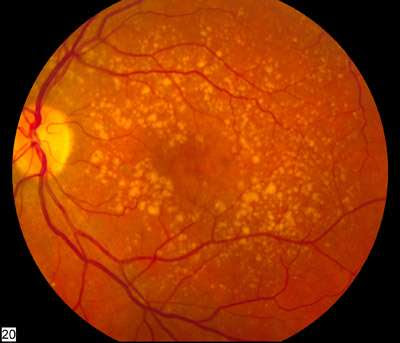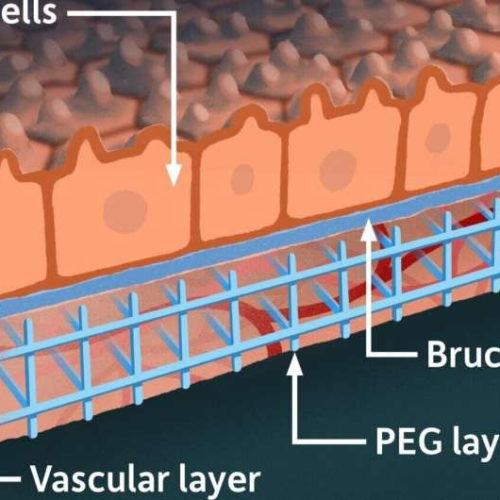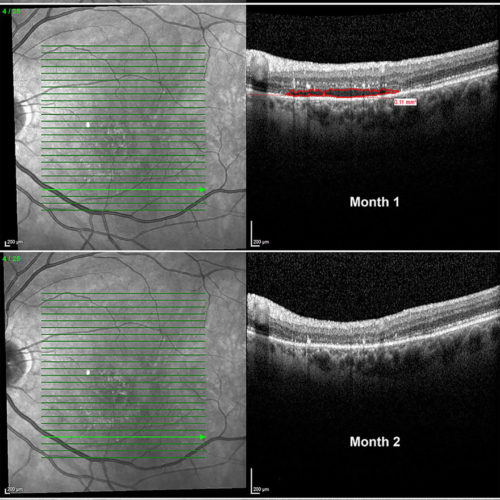by University of Virginia Credit: Pixabay/CC0 Public Domain Damaging DNA builds up in the eyes of patients with geographic atrophy, an untreatable, poorly understood form of age-related macular degeneration that causes blindness, new research from the University of Virginia School of Medicine reveals. Based on the discovery, the researchers think it may be possible to treat the disease with common...
Tag: <span>macular degeneration</span>
First biosimilar approved for macular degeneration, other eye conditions
(HealthDay)—The first biosimilar to Lucentis (ranibizumab injection) has been approved for the treatment of neovascular (wet) age-related macular degeneration and other eye diseases and conditions, the U.S. Food and Drug Administration announced Friday. The approval of the biosimilar, Byooviz (ranibizumab-nuna), is also indicated to treat macular edema after retinal vein occlusion and myopic choroidal neovascularization. Byooviz is...
Researchers: HtrA1 augmentation is potential therapy for age-related macular degeneration
by University of Utah Health Sciences A fundus photo showing intermediate age-related macular degeneration. Credit: National Eye Institute, National Institutes of Health Research conducted at the Sharon Eccles Steele Center for Translational Medicine (SCTM) at the University of Utah’s John A. Moran Eye Center explains why people carrying a block of genetic variants strongly associated with the...
A frozen leap forward for age-related macular degeneration stem cell-based therapy
by Britney Pennington and Lincoln V. Johnson, University of California – Santa Barbara Credit: CC0 Public Domain Scientists at UC Santa Barbara, University of Southern California (USC), and the biotechnology company Regenerative Patch Technologies LLC (RPT) have reported new methodology for the preservation of RPT’s stem cell-based therapy for age-related macular degeneration (AMD). The new research,...
Lab model offers hope for macular degeneration patients
by University of Rochester An illustration of the lab model that mimics the part of the human retina affected in macular degeneration. The model combines stem cell-derived retinal tissue and vascular networks from human patients with bioengineered synthetic materials in a 3D “matrix.” Credit: University of Rochester illustration / Michael Osadciw Age-related macular degeneration (AMD), which...
DoD-funded effort to restore vision to injured service members and people with disease
A team of researchers led by the University of Wisconsin–Madison professor David Gamm is developing a transplantable retinal patch intended to help restore vision to military personnel blinded in the line of duty and to treat individuals with degenerative eye diseases such as macular degeneration. Retina is the only part of the central nervous system...
Levodopa may improve vision in patients with macular degeneration
The widely used and well-tolerated drug commonly used to treat Parkinson’s disease may help significantly reduce the need for more costly, more invasive treatments, report investigators in The American Journal of Medicine ELSEVIER IMAGE: SPECTRAL DOMAIN ? OPTICAL COHERENCE TOMOGRAPHY IMAGES OF THE SAME MACULAR SEGMENTATION LINE AT BASELINE AND MONTHLY FOLLOW-UP VISITS IN A...
Exercise can slow or prevent vision loss, study finds
EXERCISE CAN SLOW OR PREVENT THE DEVELOPMENT OF MACULAR DEGENERATION AND MAY BENEFIT OTHER COMMON CAUSES OF VISION LOSS, SUCH AS GLAUCOMA AND DIABETIC RETINOPATHY, ACCORDING TO NEW RESEARCH FROM… view more CREDIT: DAN ADDISON | UVA COMMUNICATIONS Exercise can slow or prevent the development of macular degeneration and may benefit other common causes of...
Study finds association between poor diet, age-related macular degeneration
by David J. Hill, University at Buffalo Participants who ate a diet high in red and processed meat, fried food, refined grains and high-fat dairy were three times more likely to develop an eye condition that damages the retina and affects a person’s central vision, according to the results of a study from the University...
Researchers find cells linked to leading cause of blindness in elderly
by Bill Hathaway, Yale University Age-related macular degeneration is one of the leading causes of blindness in the elderly, affecting more than 2 million people in the United States and leading to progressive loss of central vision. Genome wide studies have identified almost three dozen genes that play a role in the disease, but exactly...








